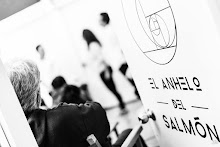Direction: Everett Dixon
Choreography: Yovanny Martinez Riaño
Assistant Choreographers/Interpretors: Jairo Lastre/Julian Garces
Lighting Design: Robinson Achinte
Musical Direction: Claudia Velez

Jairo Lastre (Cimarron) and Julian Garces (Dog) in the premiere of The Fugitives by Alejo Carpentier, February 19, 2009. University Hall, Javeriana University, Cali. (Photo: Claudia Vélez)
DANCE-THEATRE: PERFECTLY REDUNDANT
The essence of dance is movement. The essence of theatre is action.
True dance is not a question of perfection of form: the dancer's impulse is not just the serene internal movement of the martial arts master, but also the expression of an irrepressible human need - a shout made movement.
True theatre isn't just a question of form either: theatre action is a conflict manifest, an internal movement which expresses an irrepressible and tragic human need.
In this sense dance and theatre are the same art - both seek to express a conflict through concrete and directed movements - and there is something about the expression "dance-theatre" which is perfectly redundant.
However, there is no doubt that the traditions and conventions of these two sister arts are different, especially in its least successful incarnations. In dance, for example, when there is perfection of form, the interpretor can hide within, their spirit can go to sleep, and the audience, lulled by the beauty of movement, falls asleep in kind. Dance tends irresistibly to an empty "poetic" beauty, to elegant forms which don't really say anything.
The theatre, on the other hand, in its intent to express more "internal" conflicts, sometimes becomes very banal for its lack of expressive means, especially its physical expressivity.
This is why these two arts need each other constantly. Dancers teach actors to be physically present on stage, to express physically what their character wants, to attain a expressive conviction and forcefulness through physically dynamic actions. And actors teach dancers to be present in the "spirit", to participate spiritually in the actions they are carrying out, to react internally and to keep focussed on clear aims, to say something real, to want something real on stage, and to express this want in concrete but spiritual actions.
In a very specific sense, dance really reaches the audience when it has action and conflict - that is to say, when it has a theatrical essence. And theatre really reaches the audience when it has an urgency to its movements, when its has a dancistic essence. It's not a question of making away with the limits between the arts, but rather of recognizing that each art needs all of the others to get to its fullest expression.
This is what we have tried to achieve in this story about true freedom, this adaptation of the famous short story The Fugitives by Aleja Carpentier – five dancers, four actor, and a theatre director: to devise forms so theatrical and yet so anchored in movement that the audience ask at the exit: was it dance or was it theatre? We shall be happy if we have achieved it at least in some moments of the play.

Nattalia Izquierdo, Camilo Jaramillo and Lina Riascos as the Animal Chorus in The Fugitives by Alejo Carpentier. Javeriana University, February 19, 2009. (Photo: Claudia Vélez)
CAST
Cimarrón - Jairo Lastre
Dog- Julián Garcés
Grey Dog - Marcela Vanegas
Peacock - Nattalia Izquierdo
English Dog - Lina Riascos
Chorus - Actors: Camilo Jaramillo, Juan Pablo Astudillo, Lina Riascos, Nattalia Izquierdo
Dancers: Marcela Vanegas, Jhair Cambindo, Andrés Cardenas
Alejo Carpentier
Cuban writer Alejo Carpentier is considered, beside Mexican Juan Rulfo and Argentinian Luis Borges, to be one of the greatest writers of Latin America. Though none of the three ever won the Nobel Prize, it is generally held that they had deserved it much more than their outstanding, but lesser, followers, such as Gabriel García Marquez and Miguel Angel Asturias. Carpentier, with his novel Kingdom of this World, is credited with having invented the style of magic realism, and his stories, like this one about an escaped slave (or Cimarron) who develops a friendship with an escaped slave-hunting dog, are unsentimental looks at how cruelty and violence are at the centre of our most fundamental need for freedom and happiness.

No comments:
Post a Comment